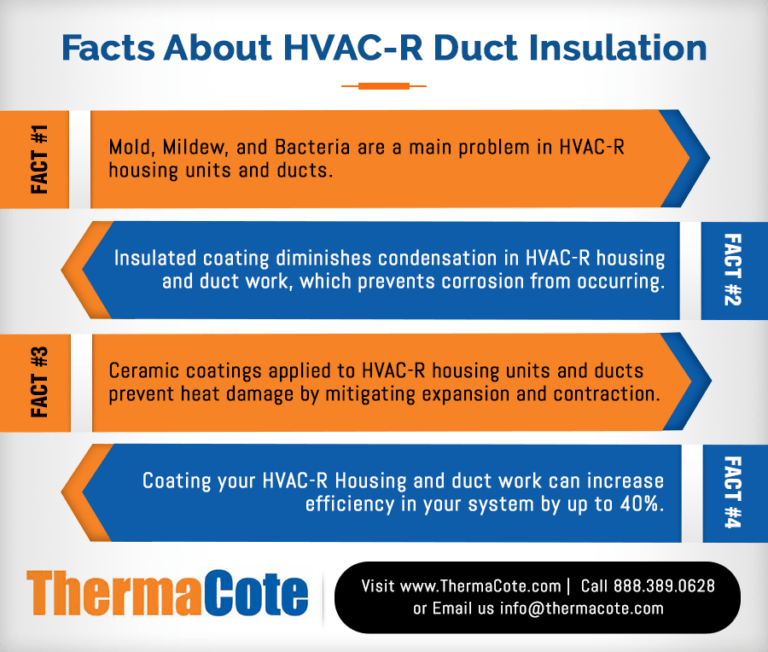ThermaCote®, Inc. has been a leader in the weather barrier market for more than 30 years providing customers with efficient solutions that address energy loss, safety and health hazards, and corrosion.
Our premier product, ThermaCote®, is a leading-edge weather and thermal barrier coating with applications ranging from construction, reduction in energy consumption, and HVAC-R insulation. ThermaCote® coating can reduce corrosion, insulate against energy transfer, reduce expansion and contraction, minimize condensation, and provide a breathable vapor barrier for better and longer-lasting weather protection.
Proper insulation of an HVAC-R system is an important step in rectifying many issues such as dripping ducts, heat damage, harmful mold, mildew, and bacterial growths within and around ducts and power inefficiencies that lead to ineffective temperature control and inflated energy bills.
Fact #1: Insulation Prevents Condensation Dripping From Ducts
When the temperature difference between the inside and outside of a duct is 10° C or more, condensation begins to form. This poses several risks to the integrity of the duct and surrounding spaces such as corrosion and dripping that can lead to expensive water damage and harmful mold growth. Insulation keeps the outer duct surfaces close to ambient temperatures and prevents this condensation from forming, preserving metal surfaces from rusting and staining.
ThermaCote® effectively insulates ducts, preventing large heat differences between your duct and the ambient air from reaching the dew point.
Fact #2: Ceramic Coatings for Duct Insulation Prevent Heat Damage
Ceramic coatings are paints mixed with one or more ceramic compounds. The ceramic compounds have excellent insulating properties and these coatings have been used for about two decades for their high effectiveness at preventing heat energy transfer in both industrial and residential spaces.
The effectiveness of this form of HVAC duct insulation is measured by the “emissivity” of the ceramic coating. Emissivity is both the ability of the surface to reflect heat as well as a measure of the amount of heat loaded onto the surface. High emissivity coatings (HEC) are used with insulating ceramics in the aerospace industry to facilitate radiative cooling under extreme conditions, such as speeds multiple times that of sound and atmospheric reentry. While the conditions your HVAC system is exposed to are likely not as extreme, ceramic coatings with a good emissivity will still offer excellent heat radiation when applied as a form of duct insulation.
Unlike other forms of duct insulation that function by slowing the transfer of heat, a ceramic coating with good emissivity reflects the heat altogether preventing it from loading onto the duct or building exterior. This is a far more effective form of insulation.
A ThermaCote® layer also offers a high reflectivity of light for exteriors, further increasing its ability to prevent heat energy from loading onto the surface.
Fact #3: Mold, Mildew and Bacteria Are a Main Problem in HVAC-R Ducts
Mold, mildew, and bacteria can present serious health concerns and are potentially very costly to have cleaned up. Harmful molds, when left unchecked, are capable of producing millions of potentially harmful spores as well as mycotoxins that can be inhaled and pose serious risks to health.
Insulation can prevent the accumulation of the moisture that cultivates these growths and can render the surface it’s applied to unsuitable for harmful microorganisms. Generally speaking, where there’s moisture there’s mold, so keeping areas with stagnant air—like the exterior of ducts—dry and free from condensation is essential not only to the longevity of the HVAC-R system but also to the health of any persons breathing that air.
Fact #4: Insulating HVAC-R Ducts Can Increase Efficiency
Proper HVAC-R sealing and insulation are both huge ways to increase the efficiency of your forced-air system and reduce energy consumption. According to the Environmental Protection Agency (EPA), proper HVAC sealing and insulation can increase efficiency by more than 20%. That means lower energy bills, more efficient temperature control in commercial and residential spaces and a very simple improvement that should pay for itself in no time.
Contact ThermaCote® for Powerful HVAC-R Solutions
Our ThermaCote® weather barrier coating is an efficient way to prevent moisture accumulation on or near your ducts, insulate your forced air systems from heat transfer, protect your exteriors from weather conditions, prevent dangerous growths, and increase power efficiency. Our coating is environmentally friendly and MAS certified green in addition to potentially reducing your carbon footprint.
If you’d like to reduce your energy bill, have any questions about our ThermaCote® barrier, or would like to discuss how we can assist with your HVAC-R insulation needs, feel free to contact us.


